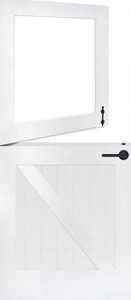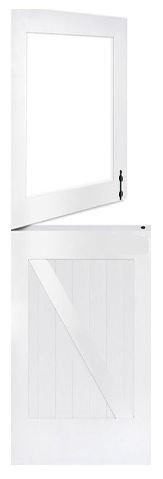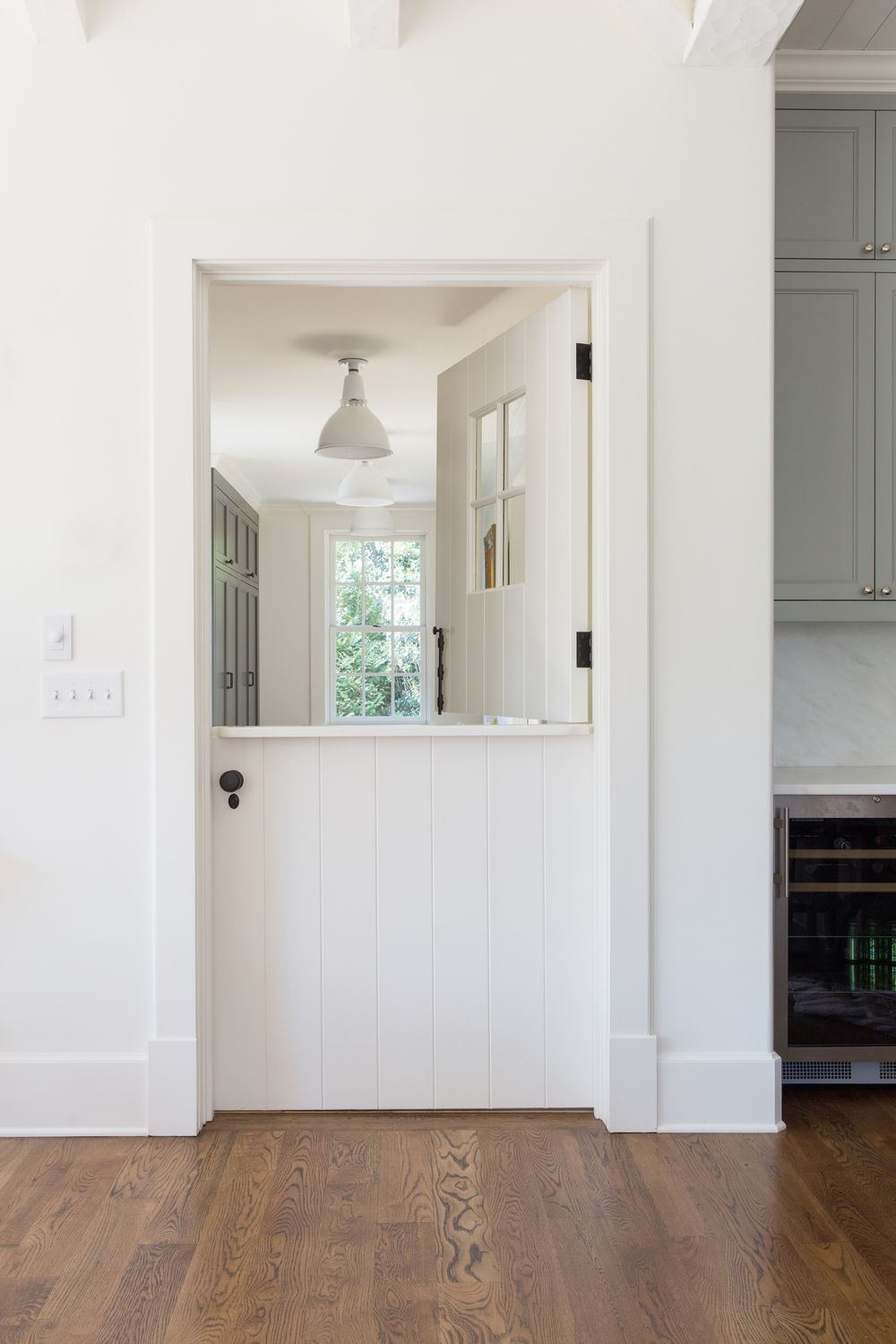
Interior Half Doors – Design Ideas for Style & Function
Half Door Interiors: Purpose, Advantages, and Ideal Locations

Half doors — also known as Dutch doors, split doors, or interior half doors — have become a stylish and functional choice for modern interiors. Whether you’re designing a cozy farmhouse kitchen, a playful nursery, or a professional office, these doors that open in half add a charming yet practical touch to your space. Combining historical charm with contemporary versatility, half doors interior designs let you control privacy, airflow, and visibility while maintaining the flow of your home. In this guide, we’ll explore the purpose, advantages, styles, and ideal locations for Dutch half doors, plus tips on choosing the right one for your needs.
Key Takeaways
- Half doors (also called Dutch half doors or interior split doors) open in two independently hinged panels for flexible light, airflow, and access.
- Great in kitchens, nurseries, offices, and laundry rooms—providing separation without full isolation.
- Style options range from rustic barn-style half doors to sleek modern designs for traditional or contemporary interiors.
- Functional benefits include keeping pets/kids safe, improving ventilation, and enhancing visibility.
- High-quality materials and hardware elevate aesthetics, durability, and potential property value.
There are several advantages to using half doors in your home or workplace. Firstly, they create an open feeling by allowing natural light and air circulation into the space. Additionally, half doors can be used to divide areas without creating a complete physical separation, making them ideal for both privacy and social interactions.
In this article, we will explore the purpose of half doors, their advantages, and the best locations to incorporate them in your interior design. Whether you are looking for a charming addition to your home or a functional solution for your workspace, half doors could be the perfect fit.
Half Door Interiors: Purpose, Advantages, and Ideal Locations
Half doors, also known as Dutch doors or split doors, are a unique and functional addition to any interior space. As their name suggests, half doors consist of two separate panels that open independently from each other. This design allows for flexibility in airflow and visibility while still providing a barrier between rooms.
There are several advantages to using half doors in your home or workplace. Firstly, they create an open feeling by allowing natural light and air circulation into the space. Additionally, half doors can be used to divide areas without creating a complete physical separation, making them ideal for both privacy and social interactions.
In this article, we will explore the purpose of half doors, their advantages, and the best locations to incorporate them in your interior design. Whether you are looking for a charming addition to your home or a functional solution for your workspace, half doors could be the perfect fit.
What is Half Door Interiors?
Half doors have been used in homes and buildings for centuries, with origins dating back to the 17th century. They were originally designed as a way to keep animals out while still letting light and air into a space. Today, they have evolved into a stylish interior feature that offers practicality and aesthetic appeal.
One of the most unique features of half doors is their ability to be opened separately or together. This allows for easy access between rooms without completely closing off the space. It also promotes better communication and social interaction, making it a popular choice for families with young children or those who frequently entertain guests.
Practically speaking, half doors are an excellent solution for rooms where a full door may be too obstructive or unnecessary. For example, in a kitchen, they provide a barrier between the cooking area and dining space while still allowing for easy movement and conversation. In an office setting, half doors can create separate workspaces without completely isolating employees.
From an aesthetic standpoint, half doors add character and charm to any interior design. They come in various styles and materials, from traditional wooden doors to modern glass panels. They also offer versatility in terms of customization, with options for different colors, hardware, and finishes to match your style.
Purpose Of Half-Door Interiors And Who Can Benefit From Them?
The primary purpose of half doors is to provide a balance between openness and privacy within an interior space. They allow natural light and air to flow through, creating a sense of openness while still providing a barrier for privacy. This makes them an ideal choice for spaces such as kitchens, laundry rooms, and nurseries.
Another practical function of half doors is their versatility in terms of usage. They can be used as room dividers, allowing for designated areas without completely closing off the space. This feature makes them beneficial for large open-concept homes or offices where separate workspaces are needed.
Half doors are also advantageous for those who have pets or young children. They can be left open at the bottom, allowing for easy movement of small animals while still keeping them contained in a designated area. This is also helpful for parents who want to keep an eye on their children while they are playing in another room.
Moreover, half doors add aesthetic value to any interior space. They can enhance the overall design and create a unique focal point in a room. With various styles and materials available, they can complement any type of interior design, from rustic farmhouse to sleek modern.
Ideal Locations for Half-Door Interiors
Half doors can be used in various locations within a home or workplace, depending on the specific needs and preferences of the individual. Some ideal locations to consider for incorporating half doors include:
- Kitchen: As mentioned earlier, half doors are an excellent option for separating the cooking area from the dining space while still promoting an open concept. Plus, they can be a charming addition to any kitchen design. And if you have pets, half doors can also be left open at the bottom to allow for easy access.
- Nursery/Playroom: Half doors are a practical choice for nurseries or playrooms, providing a barrier while still allowing parents to keep an eye on their children. They can also be useful in homes with shared bedrooms, creating separate spaces for each child without completely closing them off.
- Laundry room: For those who live in smaller spaces, such as apartments or condos, half doors are an efficient way to create a designated laundry area without taking up too much space. Additionally, they allow for ventilation and natural light in a typically small and enclosed space.
- Office: As mentioned earlier, half doors can be used to create separate workspaces within an office while still promoting communication and collaboration among employees. They also add a unique touch to the overall office design.
Half doors are a versatile and practical addition to any interior space. By understanding their purpose, advantages, and ideal locations, you can determine if they are the right fit for your home or workplace. With so many benefits and design options available, it's no wonder that half doors have stood the test of time as a popular interior feature.
Does Half Door Interiors Affect Property Value?
As with any home improvement or design feature, half doors can potentially affect property value. However, the impact will vary depending on the location and style of the doors. Generally, well-designed and functional half doors can add value to a property by enhancing its overall appeal.
In terms of location, half doors in high-traffic areas such as kitchens and living rooms may have a more significant impact on property value compared to those in less frequently used spaces like laundry rooms or offices. This is because they are more visible and play a larger role in the functionality of the room.
The style and material of half doors can also affect their impact on property value. High-quality doors made from durable materials such as hardwood or glass can add a luxurious and upscale touch to a property, potentially increasing its value. On the other hand, cheap or poorly designed half doors could hurt property value.
Ultimately, incorporating well-designed and functional half doors into your interior design can be a positive factor in terms of property value. However, it is essential to ensure that they are suitable for the location and complement the overall design aesthetic of your home.
How To Choose The Right Half Door For Your Space
When considering incorporating half doors into your interior design, there are several factors to keep in mind to ensure you choose the right one for your space. Some essential considerations include:
- Functionality: Before choosing a half door, think about its purpose and how it will be used in the specific location.
- Style and material: As mentioned earlier, half doors come in various styles and materials.
- Size: Measure the space where you plan to install the half door to ensure you choose the right size.
- Budget: Set a budget beforehand and stick to it.
- Installation: Consider whether you’ll DIY or hire a professional.
By considering these factors, you can choose the right half door for your space that not only adds functionality but also enhances its overall design aesthetic.
FAQs
Can an existing door be converted into an interior Dutch door?
Absolutely! Transforming an existing door into an interior Dutch door is a popular DIY project. This split door style allows you to maintain visibility and airflow between rooms while controlling access. For a sturdy and functional conversion, ensure that the cuts are precise, and consider adding oil-rubbed bronze hardware for a durable and stylish finish.
What are the benefits of installing a double Dutch door in a closet?
Double Dutch doors are an excellent choice for closet applications, especially in spaces where you want to combine accessibility with aesthetic appeal. These doors function similarly to traditional stable doors but with a unique, modern twist. They allow you to open the top half for ventilation or interaction, while the bottom half remains closed to keep contents discreetly hidden.
How do sliding barn doors compare to exterior Dutch doors in terms of functionality?
Sliding barn doors and exterior doors serve different functional needs, but can both enhance the door style of a home. Sliding barn doors are ideal for areas with limited swing space, offering a space-saving solution without compromising on style. Exterior Dutch doors, on the other hand, provide versatility by acting as both a window and a door, perfect for enjoying the weather without opening the door fully.
What is the advantage of a modern Dutch door over a double-hung door for interior use?
A modern Dutch door offers distinct advantages for interior use, particularly in terms of versatility and style. Unlike a double-hung door, which consists of two sashes that move vertically, a modern diy Dutch door features a split that can independently open the top while keeping the bottom closed. This makes it ideal for keeping pets or small children within a designated space while allowing light and conversation to flow freely.
Next Steps
Half doors have endured as a timeless design choice, balancing beauty, functionality, and versatility. Whether you choose a dutch half door for your kitchen, a half door barn door for a rustic touch, or a sleek modern split doors interior design for your office, the right choice will enhance both your lifestyle and your property’s appeal.
Ready to Add a Half Door to Your Space?
At Swinging Cafe Doors, we offer a wide selection of swinging doors, hardware, and customization options to suit every style — from traditional dutch half doors to modern louvre and barn-style split doors. Request a custom today or explore our online shop to find your perfect door.

